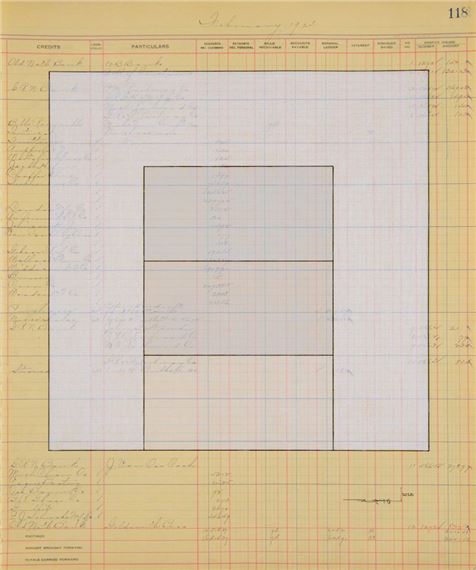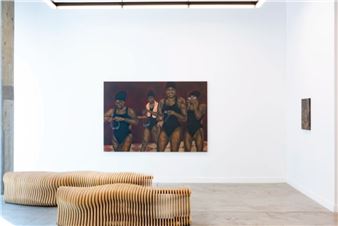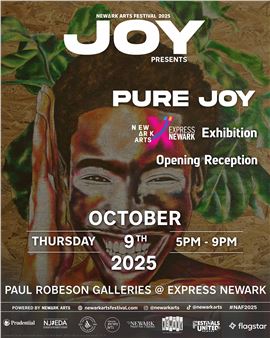Terran Last Gun: Visual Reaffirmation
Chapter NY is excited to present Terran Last Gun: Visual Reaffirmation, the artist’s first solo exhibition in New York City. The exhibition will feature a new series of abstract drawings on antique ledger sheets, further expanding this element of Last Gun’s practice.
Last Gun considers relationships between color, form, land, and the cosmos, influenced by his own experiences and cultural heritage as a member of the Piikani Nation. His geometric abstractions combine visual references to ancient Indigenous North American culture with a contemporary artistic approach informed by his background in printmaking, painting, and photography. Simultaneously engaging with history, the present, and optimism for the future, his works constantly shift across timelines.
Ledger drawings emerged in the late 19th century, primarily created by Plains Indians to document aspects of daily life such as hunting and battle scenes. Artists depicted representational subjects on repurposed paper sourced from accounting ledger books, partly due to its accessibility. Last Gun’s abstract compositions, however, depart from traditional narrative ledger drawings, deriving formal inspiration from the aesthetics of Blackfoot painted lodges, hides, war shirts, and archaeological artifacts throughout Montana and Alberta.
The exhibition features two recurring compositions: individual works with square forms symbolizing doorways and diptychs with rectangular forms representing windows. Both doors and windows serve as gateways to new ways of thinking, offering a transportive quality that invites exploration. Last Gun’s individual works expand his ongoing interest in the square form and its symmetry. In these compositions, he fills the squares completely with color, allowing the ledger paper to remain visible through the colored pencil. These doorways reference Blackfoot painted lodges, specifically doorways painted on the back of the lodges, which were often considered spirit doors and positioned to face the sunset. Last Gun’s diptychs, with their extended horizontal orientation, evoke the feeling of landscapes. By combining two separate sheets of paper, he explores the duality and energy created through their connection.
Last Gun distinguishes each work through his use of color, exploring both monochromatic and complementary palettes. His practice remains firmly rooted in color theory and color relativity, with a continuous interest in understanding why people are drawn to specific colors. The color wheel plays a central role in the artist’s process, guiding him to select color schemes that create harmony and engage the viewer. In his work Important Ideas Come Into Existence (2025), he focuses solely on various shades of white, investigating the subtlety and depth that can be achieved within a single color.
A notable feature of Last Gun’s exhibition is the use of ledger paper dated 1923 and 1924, gifted to the artist by his father and an anonymous donor from Tucson. The dates remain legible within the artist’s work and reference the historical context of those eras of hardship for all Indigenous communities. By using historical paper, he breathes new life into it, reintroducing and emphasizing the history of his people in the broader, mainstream narrative of North America.

Recommended for you
Chapter NY is excited to present Terran Last Gun: Visual Reaffirmation, the artist’s first solo exhibition in New York City. The exhibition will feature a new series of abstract drawings on antique ledger sheets, further expanding this element of Last Gun’s practice.
Last Gun considers relationships between color, form, land, and the cosmos, influenced by his own experiences and cultural heritage as a member of the Piikani Nation. His geometric abstractions combine visual references to ancient Indigenous North American culture with a contemporary artistic approach informed by his background in printmaking, painting, and photography. Simultaneously engaging with history, the present, and optimism for the future, his works constantly shift across timelines.
Ledger drawings emerged in the late 19th century, primarily created by Plains Indians to document aspects of daily life such as hunting and battle scenes. Artists depicted representational subjects on repurposed paper sourced from accounting ledger books, partly due to its accessibility. Last Gun’s abstract compositions, however, depart from traditional narrative ledger drawings, deriving formal inspiration from the aesthetics of Blackfoot painted lodges, hides, war shirts, and archaeological artifacts throughout Montana and Alberta.
The exhibition features two recurring compositions: individual works with square forms symbolizing doorways and diptychs with rectangular forms representing windows. Both doors and windows serve as gateways to new ways of thinking, offering a transportive quality that invites exploration. Last Gun’s individual works expand his ongoing interest in the square form and its symmetry. In these compositions, he fills the squares completely with color, allowing the ledger paper to remain visible through the colored pencil. These doorways reference Blackfoot painted lodges, specifically doorways painted on the back of the lodges, which were often considered spirit doors and positioned to face the sunset. Last Gun’s diptychs, with their extended horizontal orientation, evoke the feeling of landscapes. By combining two separate sheets of paper, he explores the duality and energy created through their connection.
Last Gun distinguishes each work through his use of color, exploring both monochromatic and complementary palettes. His practice remains firmly rooted in color theory and color relativity, with a continuous interest in understanding why people are drawn to specific colors. The color wheel plays a central role in the artist’s process, guiding him to select color schemes that create harmony and engage the viewer. In his work Important Ideas Come Into Existence (2025), he focuses solely on various shades of white, investigating the subtlety and depth that can be achieved within a single color.
A notable feature of Last Gun’s exhibition is the use of ledger paper dated 1923 and 1924, gifted to the artist by his father and an anonymous donor from Tucson. The dates remain legible within the artist’s work and reference the historical context of those eras of hardship for all Indigenous communities. By using historical paper, he breathes new life into it, reintroducing and emphasizing the history of his people in the broader, mainstream narrative of North America.
Artists on show
Contact details

Related articles
After several years during which galleries have focused relentlessly on narrative and figurative work, I feel a vibe shift in the air. Is it wishful thinking or is abstract painting roaring back?

 ARTISTS
ARTISTS









